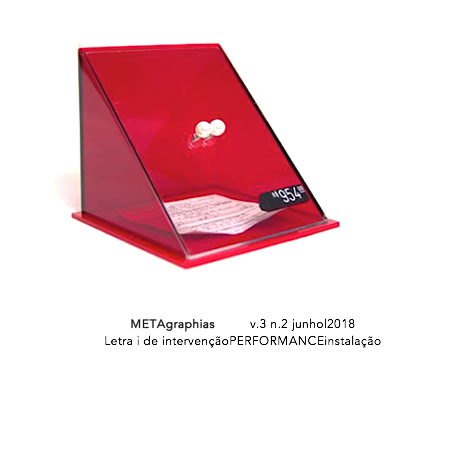(Foto)performance no Sítio Arqueológico de Pompeia, Itália
o ser artista-turista
DOI:
https://doi.org/10.26512/mgraph.v3i2.19751Keywords:
Pompeii, Performance, Photoperformance, Art-Tourism, Dérive, FlâneurAbstract
The following essay invites us to reflect about a performatic afternoon inside the Pompeii Archeological Area, in Italy, a city destroyed by the Vesuvius eruption and whose ruins remained being a target for the tourists. So, having this place as a poetic catalyzer, how does an artist behave in a touristic area? How can one act proper to oneself being an artist and a tourist in there? To answer that questioning, I bring forth the Theory of the Dérive by Guy Debord (1931 ”“ 1984) and about the flâneur from Walter Benjamin (1892 ”“ 1940). Artist-tourist is that one that flanes the streets searching for (or not) something that he doesn’t acknowledge what it is, drifting, feeling the urbanism flavor through his/her skin. The text also explores how the trip-artwork to the ruins was, how the performance went and the art registry’s poetic outspreading besides a reflection on what is like to be a tourist and artist at the same time.
Downloads
References
SMITH, Dan. Pompeii. Intérpretes: Bastille. In: Bad Blood. Londres: Virgin Records, 2013.
BEARD, Mary (2008). Pompeii: The Life of a Roman Town. Profile Books. ISBN 978-1-86197-596-6.
BENJAMIN, Walter. Obras escolhidas III: Charles Baudelaire um lírico no auge do capitalismo. 3ª ed. São Paulo: Ed. Brasiliense, 1989.
COSTA, Luiz Cláudio da Costa (org.). Dispositivos de registro na arte contemporânea. Rio de Janeiro: FAPERJ, 2009.
ALBUQUERQUE, N.; MEDEIROS, M. B. de. Composição Urbana: surpreensão e fuleragem. Disponível em: http://grafiasdebiamedeiros.blogspot.com.br/2014/05/composicao-urbana-surpreensao-e.html. Acesso em: 27/11/2016, 22:01.
DEBORD, Guy et al. Potlach. Volume 14. Paris, 1954. Reimpresso em Potlatch 1954-1957.
DEBORD, Guy. “Teoria da Deriva”. Disponível em: https://teoriadoespacourbano.files.wordpress.com/2013/03/guy-debord-teoria-da-deriva.pdf. Acesso em 29/11/2016, Ã s 00:09.
GOLDBERG, Roselee. A arte da performance ”“ do futurismo ao presente. São Paulo: Martins Fontes, 2006.
LINKE, Ines. This Land Your Land: turismo, transgressão e mobilidade. In: Cirillo, José; Teresa Espantoso R. y Carolina Vanegas C. (orgs.) II Seminario Internacional sobre Arte Público en Latinoamérica. Arte público y espacios políticos: interacciones y fracturas en las ciudades latinoamericanas. Vitória, Brasil: UFES, Comarte, 2011. P. 345 ”“ 356.
__________. THIS LAND YOUR LAND JOURNEYS. Disponível em: http://thislandyourlandtrabalhoseprojetos.blogspot.com.br/2011/04/this-land-your-journeys.html. Acesso em 24/11/16, Ã s 16:41
LAURENCE, Ray. Roman Pompeii, Space and Society. London: Routledge, 1994
MASSAGLI, Sergio Roberto. Homem da multidão e o flâneur no conto “O homem da multidão” de Edgar Allan Poe. In: Terra roxa e outras terras ”“ Revista de Estudos Literários Volume 12 (Jun. 2008) ”“ 1-170. ISSN 1678-2054. Disponível em http://www.uel.br/pos/letras/terraroxa/g_pdf/vol12/TRvol12f.pdf
OPA, Matheus K. Espaços de Mnemosine ”“ apropriação de memória em site specific com fotoperformance. In: VENTURELLI, S. e ROCHA, C. (orgs.). Anais do 16º Encontro Internacional de Arte e Tecnologia. Brasília, Brasil: Universidade de Brasília, 2016. ISSN 2239-0272. Disponível em: https://art.medialab.ufg.br/up/779/o/Matheus_Opa.pdf
Downloads
Published
How to Cite
Issue
Section
License
Autores têm permissão e são estimulados a publicar e distribuir seu trabalho online (ex.: em repositórios institucionais ou na sua página pessoal) a qualquer ponto antes ou durante o processo editorial, já que isso pode gerar alterações produtivas, bem como aumentar o impacto e a citação do trabalho publicado.


